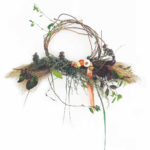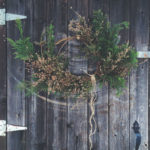The days are shorter. We move inside and want to bring the landscape with us. We start with dried bouquets, then move to wreaths, garlands, and soon, maybe, the tree.
Now is the time to walk the garden for wreath- and garland-making materials; the landscape offers much to work with. A snaky tangle of bittersweet or wild grapevine can be woven into garlands or wreaths. Do without the yellow-orange berries of the bittersweet, though, and just let the flexible brown vines provide the structure you need. Removing the berries once you bring the vine indoors will help stop the spread of this invasive plant.
Cutting back the perennials? Grasses and dried seed pods add interesting texture to arrangements. While forsythia and privet won’t last too long once cut, their usual green leaves are painted with beautiful autumnal color at this time of year. Their sturdy branches are easy to work with and give support to the wreath or garland structure. Evergreens are perfect as a base layer; the green color continues long into the season even when cut, and the needles are perfect for tucking in and attaching other plant materials to. Driftwood, feathers, cut flowers, and shells could add further interest.
Besides what you’ve collected to make your wreath, you’ll need a good pair of gardening shears and some floral wire. Gloves will come in handy, too.
Begin a garland by wrapping the small offshoot branches of a long piece of bittersweet around itself. Extend the length of your garland by lining up a new piece of bittersweet about halfway along your wrapped branch, and begin weaving and wrapping its shoots onto the first branch. Add more branches, wrapping them onto each other, until your garland reaches the length and fullness you’re looking for. If needed, reinforce the meeting points by wrapping them together with floral wire.
For making a wreath, bring the garland into a circular shape. Now, take the two ends and tie them together in a knot, winding and weaving any remaining branches around the shape.
Once your overall shape is complete, hang your wreath or garland — if possible, directly in its designated spot. Hanging beforehand reveals where any extra support will be needed and helps you see your composition take shape as you work.
Begin composing the elements you’ve gathered. Refer to the landscape for inspiration, noting how shape, texture, color, and contrast play together. Decide if you’d like to cover the whole structure, or just some key spots. Will the bittersweet vine structure show, or will you cover it with a base layer of cedar or pine? Continue weaving in the materials you’ve gathered until your wreath or garland feels full and finished. Step back often while you work, making sure the piece looks and feels well balanced.
Although they look lovely inside, hanging these creations outdoors and away from heat ensures them a longer life, and any seeds or berries in the arrangement offer fodder for visiting birds. You can bring your wreath or garland deeper into the winter season by removing autumn grasses and replacing them with evergreens and pine cones.




